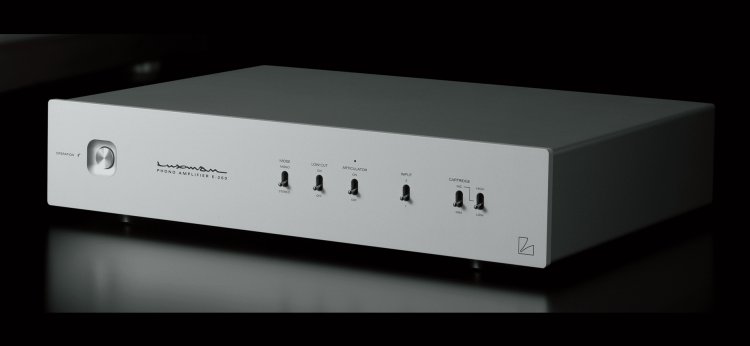The Luxman E-250 - Fantastic Phono Preamplifier

When you open the box on the E-250, you still feel like royalty: the phono preamp is an unassuming but gorgeous device - nothing to hide someplace under the turntable, but a hi-fi gem that you want to see, touch, and control, and that deserves its own space throne.
The case has a standard folding tin lid rather than the thick-walled wood or aluminum design of the other variants. Its format also makes the E-250 stand out in the brand environment: 36 cm wide, not quite full format, but not midi either, no other Luxman product has it - save for the E-200, which was available from 2008 to 2012.
There are also technological similarities - in a straight comparison, the new smartphone is plainly more appealing. When you think that the E-200 cost 1900 USD in 2012 and that ten years have gone, the price of the 250 feels almost like a special offer.
A lot has changed on the E-250, both internally and externally — generally for the better.
The R cores, which were previously featured in high-end Sony equipment, are very low in dispersion and vibration, which is perfect for a phono stage. The test gadget, on the other hand, did not emit any hum, either mechanically or electronically, thus the savings here are meaningless.

On the other hand, another noticeable improvement is that the E-250 may now be substantially customized to the pickup used at its MM input. This is especially nice because the old one's termination impedance was not only irreversible but also adversely high for many systems. Instead of a fixed 350 picofarads, the E-250 now provides linked MMs with a choice of 0, 100, 220, or 320 pF.
Small values, in particular, can represent the difference between tight, strained, and balanced, broadband sound in many current magnet systems. For unique system instances, which are not uncommon, you can also adjust the terminating resistor from the conventional 47k to 34, 56, or 100k, which, when combined with the capacitance values specified, guarantees optimal conditions for virtually every high-output pickup in the universe.
The MM amplification process is divided into two stages: Four JFETs wired in parallel per channel ensure low-noise gain on the input side. The semiconductors have perfect qualities for phono usage, but they must be carefully chosen. The JFETs are followed by a stereo op-amp, the identification of which is concealed beneath a glued-on copper plate. The RIAA equalization is half active (in the op amp's negative feedback) and half passive.

Two elegant, encased transformers with Supermalloy cores, which Luxman spins himself and also utilizes in the larger versions, provide the essential first voltage boost for MC signals. The transformers, which are essentially small, highly specialized transformers, work fully passively and amplify completely without contributing any noise.
With a toggle switch and relay, you may select between two transformer inputs: "MC Low" makes the primary winding very low-impedance and enhances the transmission factor - the ideal connection for quiet MC systems like the Ortofon SPU or the Linn Klyde.
"High" amplifies a few decibels less but shuts the pickup with a greater impedance, which is appropriate for MCs with mild double-digit coil impedance. In this position, our Thorens TAS-1600, for example, felt most at ease. There are, of course, exceptions, such as silent systems with very high-impedance coils.
Once you've picked between MC low and MC high - which you can easily determine by toggling back and forth on the front panel - there are a few more variables that affect both sorts of systems: A decent subsonic filter functions well against flapping loudspeaker membranes, but it is not fully inaudible on broadband chains. And a mono switch, which has a variety of applications: Sure, it makes old mono LPs sound quieter and cleaner.
The primary circuit board is separated lengthwise into two elongated playing fields: in the back, the signal path runs from right to left, bordered by relays that implement all of the on-site setup options. A luxury power supply with individual voltage regulators for phono equalization is firmly packed in the front half.
The components are likewise of high quality: precise resistors, custom-made electrolytic capacitors with Luxman writing, and unusual film capacitors populate the typically outfitted circuit board. What shines through beneath the components is likewise lovely: an artistic circuit arrangement with wide, gently curved copper tracks that indicates a lot of love and attention.
Technical concept: Phono amplifier for MM + MC Input impedance MM: 4 kO / 47 kO / 56 kO / 100 kO Input capacitance MC : 0 pF / 100 pF / 220 pF / 320 pF) Outputs: 1 x Phono RCA Inputs : 2 x Phono RCA Particularities: Built-in pickup demagnetizer Dimensions (W x H x D): 36,4 x 8,1 x 27,4 cm Weight: 4,3 Kg





























